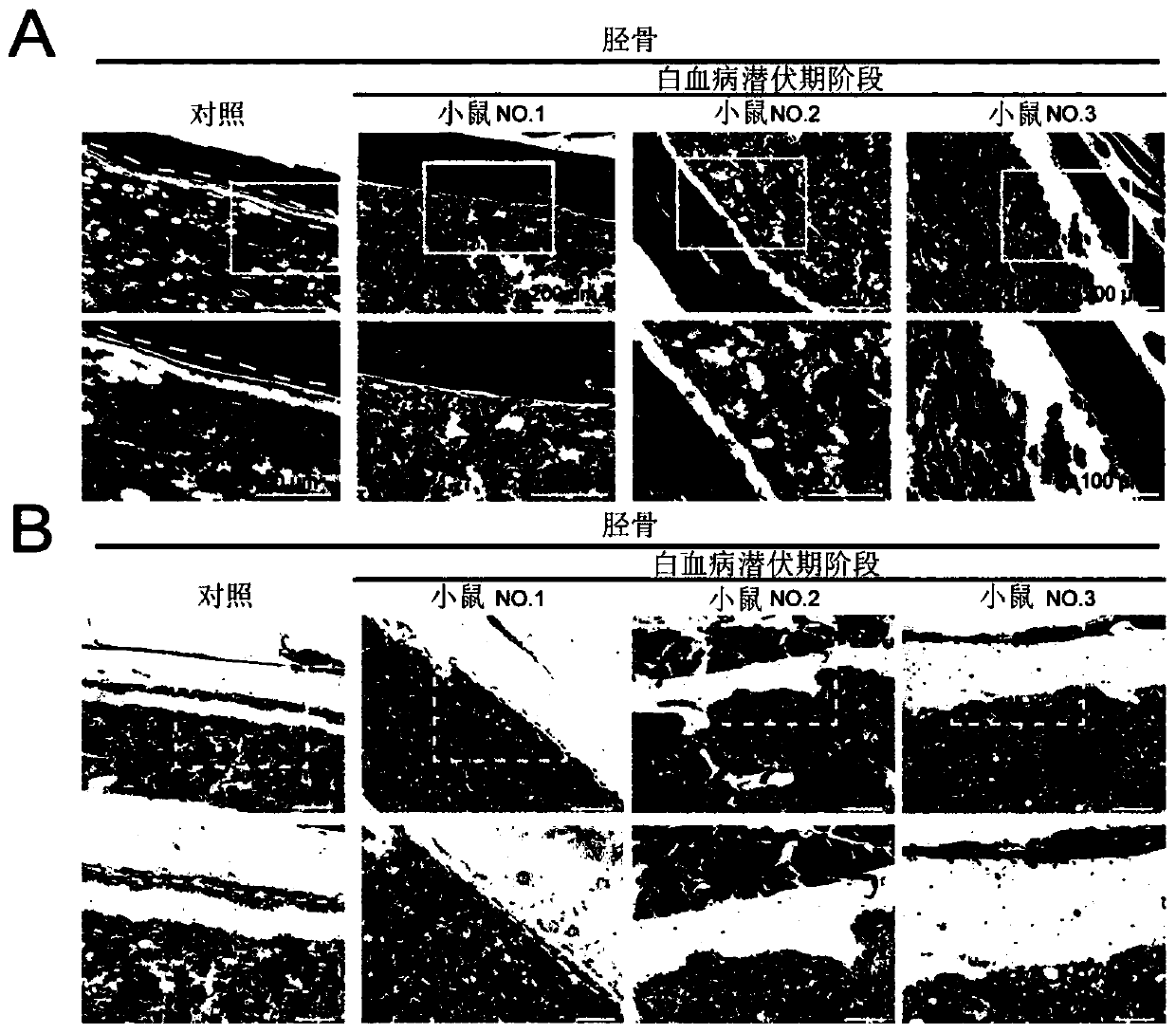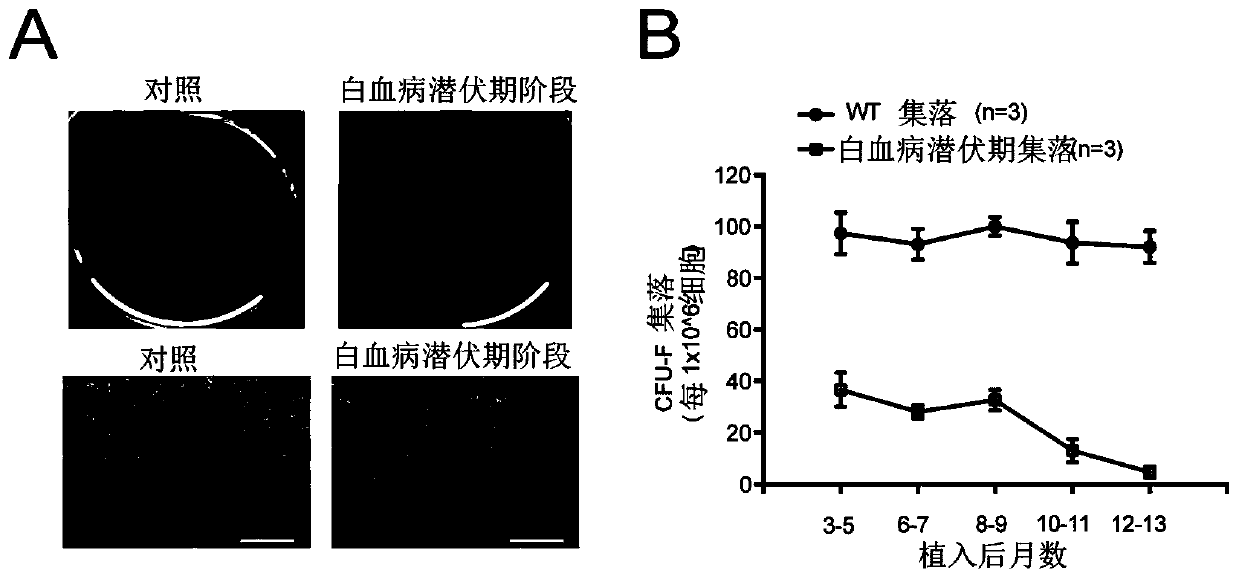A way to remodel the bone marrow microenvironment
A technology of microenvironment and bone marrow, which is applied in the direction of medical formula, bone/connective tissue cells, medical preparations containing active ingredients, etc., can solve the problems of remodeling of pathological bone marrow microenvironment, restore normal bone marrow hematopoietic function, and achieve rejuvenation. The effect of shaping and prolonging the lifespan
- Summary
- Abstract
- Description
- Claims
- Application Information
AI Technical Summary
Problems solved by technology
Method used
Image
Examples
Embodiment 1
[0062] Example 1 Establishment of a mouse leukemia (CMML / JMML-like) model of progressive destruction of the bone marrow microenvironment
[0063] Leukocytes (stromal cell-depleted) from NrasG12D mutant mice (LSL NrasG12D / +; Vav-Cre) or control mice (CD45.2) were transplanted into sublethally irradiated (6.5Gy) CD45 .1 Recipient mice to construct a mouse leukemia model of chronic myelomonocytic leukemia (CMML / JMML-like). The burden and proliferation of tumor cells in peripheral blood were analyzed monthly by flow cytometry. In the leukemia mouse model induced by NrasG12D, the different stages of leukemia development were defined according to the proportion of myeloid cells in the peripheral blood of the mice. When the myeloid cells (Mac1) in the peripheral blood of the mice were greater than 20% and less than 60%, It is the pre-leukemic phase (Pre-leukemic phase, sometimes referred to as PL phase hereinafter), and when Mac1>60%, it is the leukemia phase (Leukemic phase).
Embodiment 2
[0064] Example 2 Histological analysis proves that endosteal osteoblasts are gradually exhausted in the bone marrow microenvironment during the incubation period of leukemia
[0065] In order to investigate whether there is a gradual depletion of the bone marrow mesenchymal microenvironment during the incubation period of NrasG12D-induced leukemia, we first sacrificed control mice and NrasG12D recipient mice in the incubation period of leukemia and isolated the tibia and femur, and treated them with 4% paraformaldehyde. Hematoxylin-eosin staining and immunohistochemical staining for osteocalcin were performed after fixation. Hematoxylin-eosin staining ( figure 1 A) The osteoblasts (osteoblast, sometimes referred to as OB) near the endosteum in the NrasG12D recipient mice showing the leukemia incubation stage have been exhausted; osteocalcin histochemical staining ( figure 1 B) Osteoblasts near the endosteum have been depleted in NrasG12D recipient mice showing the leukemia la...
Embodiment 3
[0066] Example 3 Cytological analysis proves that with the development of leukemia, the mesenchymal stromal cells (MSCs) in the bone marrow microenvironment are gradually exhausted
[0067] To assess the depletion of functional mesenchymal stromal cells in NrasG12D recipient mice, we performed a fibroblast colony-forming unit assay (CFU-F). After first sacrificing the mice, the bone marrow nucleated cells (BMNC) were aseptically isolated and counted, and 1x10 cells from each mouse in the three groups 6 BMNC with 2mL MesenCult TM Complete medium (Catalog 05512, StemCell Technology) was suspended and seeded in a single well of a six-well plate. In a cell culture incubator at 37°C, 5% CO 2 Cultivate under the same conditions until the 7th day, and continue to culture for 3-7 days after replacing half of the medium on the 7th day. When the culture reaches the 10th-14th day, fix the cells with pre-cooled ethanol and perform Wright's Giemsa staining, and count the formed Number o...
PUM
 Login to View More
Login to View More Abstract
Description
Claims
Application Information
 Login to View More
Login to View More - R&D
- Intellectual Property
- Life Sciences
- Materials
- Tech Scout
- Unparalleled Data Quality
- Higher Quality Content
- 60% Fewer Hallucinations
Browse by: Latest US Patents, China's latest patents, Technical Efficacy Thesaurus, Application Domain, Technology Topic, Popular Technical Reports.
© 2025 PatSnap. All rights reserved.Legal|Privacy policy|Modern Slavery Act Transparency Statement|Sitemap|About US| Contact US: help@patsnap.com



